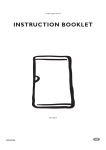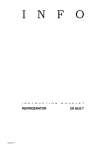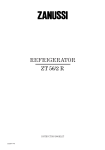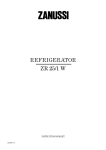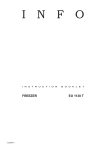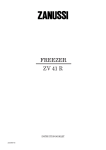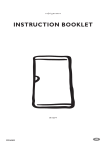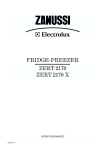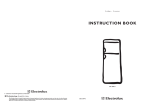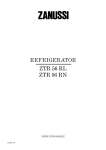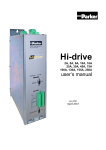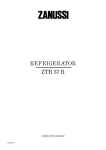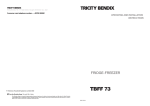Download Electrolux ER 1627T User's Manual
Transcript
refrigerator INSTRUCTION BOOKLET ER 1627 T 2222 638-23 UK CONTENTS Instructions for the User Instructions for the Installer Important Safety Instructions 3 Technical Specifications 11 Description of the Appliance 4 Installation 11 Operation 5 Before use Setting the temperature Fresh food refrigeration The door shelves The -star compartment Frozen food storage Thawing Making ice cubes Normal operating sounds 5 5 5 6 6 6 6 6 7 Positioning Door reversal Health and Safety Guidelines 7 Defrosting 8 Maintenance and Cleaning 9 Internal cleaning External cleaning Changing the light bulb When the appliance is not in use 9 9 9 9 Something Not Working? 10 Service and Spare Parts 10 Electrical Connection 2 11 12 13 IMPORTANT SAFETY INSTRUCTIONS These warnings are provided in the interests of your safety. Ensure that you understand them all before installing or using this appliance. Your safety is of paramount importance. If you are unsure about any of the meanings of these warnings contact the Customer Care Department. Prior to Installation ■ General Safety Check the appliance for transport damage. Under no circumstance should a damaged appliance be installed. In the event of damage please contact your retailer. ■ ■ Installation ■ ■ ■ ■ ■ ■ This appliance is heavy. Care should be taken when moving it. It is dangerous to alter the specifications or attempt to modify this product in any way. Ensure that the appliance does not stand on the electrical supply cable. Important: if the supply cable is damaged, it must be replaced by a cable available from the manufacturer or Expert Appliance Care. Any electrical work required to install this appliance should be carried out by a qualified electrician or competent person. Parts which heat up should not be exposed. Whenever possible, the back of the appliance should be close to a wall, but leaving the required distance for ventilation, as stated in the installation instructions. The appliance should be left for 2 hours after installation before it is turned on, in order to allow the refrigerant to settle. ■ ■ ■ During Use ■ ■ ■ This appliance is designed for domestic use only, specifically for the storage of edible foodstuff. It is not intended for commercial or industrial use. ■ Containers with flammable gases or liquids can leak at low temperatures. Do not store any containers with flammable materials, such as spray cans, fire extinguisher refill cartridges etc. in the refrigerator. Frozen food should not be refrozen once it has thawed out. Do not place carbonated or fizzy drinks in the freezer compartment. Ice lollies can cause ‘frost/freezer burns’ if consumed straight from the -star compartment. Do not remove items from the freezer compartment if your hands are damp/wet, as this could cause skin abrasions or frost/freezer burns. Bottles and cans must not be placed in the freezer compartment they can burst when the contents freeze. Manufacturers’ recommended storage times should be adhered to. Refer to relevant instructions. ■ Refrigerant ■ ■ The refrigerant isobutane (R600a) is contained within the refrigerant circuit of the appliance, a natural gas with a high level of environmental compatibly, which is nevertheless flammable. During transportation and installation of the appliance, be certain that none of the components of the refrigerant circuit become damaged. If the refrigerant circuit should become damaged: - avoid open flames and sources of ignition. - thoroughly ventilate the room in which the appliance is situated. ■ ■ ■ ■ Child Safety ■ ■ This appliance contains hydrocarbons in its cooling unit; maintenance and recharging must therefore only be carried out by authorised technicians. Take utmost care when handling your appliance so as not to cause any damages to the cooling unit with consequent possible fluid leakages. The appliance must not be located close to radiators or boilers. Avoid prolonged exposure of the appliance to direct sunlight. Do not use other electrical appliances (such as ice cream makers) inside of refrigerating appliances. Do not allow children to tamper with the controls or play with the product. There is a risk of suffocation! Keep packaging material away from children! Maintenance and Cleaning ■ ■ 3 Before cleaning, always switch off the appliance and disconnect from the electrical supply. When unplugging always pull the plug from the mains socket, do not pull on the cable. Servicing ■ ■ This product should be serviced by an authorised engineer and only genuine spare parts should be used. Under no circumstances should you attempt to repair the appliance yourself. Repairs carried out by inexperienced persons may cause injury or serious malfunctioning. Contact Expert Appliance Care. At the end of the Appliance Life ■ ■ When disposing of your appliance use an authorised disposal site. Remove the plug and ensure that any locks or catches are removed, to prevent young children being trapped inside. DESCRIPTION OF THE APPLIANCE ➇ ➆ ➀ ➈ ➁ ➅ ➄ ➃ ➂ ➀ Dairy compartment ➁ Can storage shelf with egg tray ➂ Bottle storage shelf ➃ Salad bin ➄ Glass shelf (for storing fresh meat) ➅ Storage shelves ➆ Thermostat control ➇ Freezer compartment ➈ Conveyor 4 OPERATION Before use Fresh food refrigeration Remove all securing tapes. Wash inside the appliance with lukewarm water and bicarbonate of soda (5 ml to 0.5 litre of water). Do not use soap or detergent as the smell may linger. Dry thoroughly. To obtain the best performance, do not store warm food or evaporating liquids in the refrigerator; do cover or wrap the food, particularly if it has a strong flavour. Do not cover the shelves with any protective material, such as paper, cardboard or plastic, which may obstruct the air circulation through them. To help you use your refrigerator correctly, here are some more useful hints: Raw meat (beef, pork, lamb, chicken or poultry): wrap in polythene bags and place on the shelf on top of the salad bin. Meat can only be stored safely in this way for one or two days at the most. Fruit & vegetables: these should be thoroughly cleaned and placed in the bottom salad bin. Butter & cheese: these should be placed in special airtight containers or wrapped in aluminium foil or polythene bags, to exclude as much air as possible. Milk bottles: these should have a cap and should be stored in the bottle rack on the door. The walls of the refrigerator are equipped with runners so that shelves can be positioned as desired. Setting the temperature The temperature inside the refrigerator and the -star compartment is regulated by a thermostat with 6 temperature positions and one «OFF» (O) position. Position 1 = minimum coldness Position 6 = maximum coldness Turn the thermostat dial to the required position. An intermediate position is usually the most suitable, although the temperature will be affected by: Room temperature l How often the door is opened l How much food is stored l Position of the appliance In determining the correct temperature control setting all these factors have to be considered and some experimentation may be necessary. When altering the temperature setting, allow 24 hours for the temperature to stablise before making further changes. l Important The temperature inside the refrigerator and -star compartment can be regulated by adjusting the conveyor located under the -star compartment. To obtain a lower temperature in the -star compartment when frozen food is stored inside and when the ambient temperature is 25°C or lower slightly raise the conveyor (A) and push it all the way in. When frozen food is not stored in the -star compartment and when the ambient temperature is higher than 25°C return the conveyor to its initial position. This reduces the temperature in the refrigerator compartment. D302 ** A D182 5 The door shelves To permit storage of food packages of various sizes the central door shelf can be adjusted in height. To do this proceed as figure. PR187 For more thorough cleaning, the top door shelf and the bottle shelf can be removed by pulling them in the director of the arrows, then refitting them in position. PR190 The -star compartment Thawing This compartment is suitable for the storage of commercially frozen food and for ice cube making. Food can be thawed in a number of ways, depending on the type of food and the size of the packs. Meat, fish and fruit should be thawed in the refrigeration compartment and small pieces of meat can even be cooked while still frozen, but you must ensure that it is thoroughly cooked through. Vegetables should be directly immersed in boiling water; ready-cooked dishes can be placed directly in the oven in their aluminium wrapping. A microwave oven is particularly suitable for thawing any type of frozen or deep-frozen food: follow the oven instructions, particularly regarding the placement of aluminium wrapping in the oven. Frozen food storage Storing ready-frozen foods is quite straight forward. The packs can be placed beside each other or on top of each other. You are strongly advised to place ready-frozen food in the compartment as quickly as possible after purchase and we therefore recommend that you buy them last. Also ensure that the external packaging is intact. Packaging which is swollen or has traces of refrozen water droplets on the pack could indicate that the product has not been kept at a suitable temperature and that it may have lost its original quality. Partially thawed food must not be refrozen, it must be consumed within 24 hours. Never exceed the storage times indicated. Do not open the -star compartment door too often and do not leave open longer than necessary. Making ice cubes The appliance is provided with a plastic ice cube tray. Fill the tray 3/4 full to allow the ice to expand and place it in the -star compartment. To turn out the ice cubes simply give the tray a slight twist to release the cubes. Never try to free an ice tray that is frozen to the -star compartment using a sharp or pointed object. Important In the event of a power cut do not open the door. The food in the -star compartment will not be affected if the power cut is short and if the compartment is full. Should the food begin to thaw, it must be consumed quickly and must not be re-frozen. Important Do not consume ice-lollies which have just come out of the -star compartment. Their extremely low temperature can cause frost burns. Do not remove items from the -star compartment if your hands are damp/wet, as this could cause skin abrasions or "frost/freezer burns". 6 Normal Operating Sounds You may hear faint gurgling or bubbling sounds when the refrigerant is pumped through the coils or tubing at the rear, to the cooling evaporator. When the compressor is on, the refrigerant is being pumped round, and you will hear a whirring sound or pulsating noise from the compressor. A thermostat controls the compressor, and you will hear a faint ‘click’ when the thermostat cuts in and out. HEALTH AND SAFETY GUIDELINES Because of consumer demand, preservatives have been removed from many pre-prepared foods. This together with the changes in shopping habits to a once-a-week shop, mean that safe handling and storage of food is even more important than ever. The following tips should help you to ensure that the food in your home is in as perfect condition as possible. ■ Keep the time between buying chilled food and placing it in your fridge as short as possible. Tests showed that the temperature of 1 litre of orange juice rose to 22°C in an hour between the supermarket and home. It then took 11 hours to get down to 7°C in the refrigerator. ■ Keep the refrigerator door closed as much as possible. ■ Do not push food together too much, try to allow air to circulate around each item. ■ Cool cooked food as quickly as possible but do NOT place in the refrigerator until cool. (Leave food in a cool place in order that it can then be placed in the refrigerator as soon as possible). ■ Do NOT mix raw and cooked meat, they must be in separate containers. Take care not to let the meat juices drip onto other food. If the meat does drip, remove everything and clean thoroughly. ■ Do not store food uncovered. ■ ■ ■ ■ ■ ■ 7 Remove suspect food from your refrigerator and clean (Refer to “Maintenance and cleaning”). Never allow spillages to dry and harden. Store eggs in the egg rack provided in the refrigerator door. Discard any broken or chipped eggs. Regularly check the refrigerator door seal to ensure that it is clean and free from debris. Always wash your hands with soapy water and dry them with a clean towel before handling food. Keep work surfaces clean and avoid cross contamination by not using the same work surface or knife, without washing them thoroughly in between. DEFROSTING While in operation the -star compartment becomes progressively covered with frost. This frost, which acts as an insulator and thus prevents the cold from reaching the food should be removed whenever the thickness of the frost exceeds 1/4". To carry out complete defrosting proceed as follows: 1. Push the conveyor completely in. 2. Place a tray on the upper shelf of the refrigerator under the drain hole of the conveyor. 3. Remove any food from inside the -star compartment, wrap it in several sheets of newspaper and store in a cool dry place. 4. Turn the thermostat dial to the «OFF» (O) position. To accelerate defrosting, place a bowl of hot water inside the compartment (with a piece of cardboard underneath the bowl as protection). 5. When defrosting is completed, dry thoroughly and remove the water collected in the tray. Turn the thermostat knob on a medium position to restart the appliance. After letting the appliance run for at least half an hour, replace the previously removed food into the star compartment. When defrosting it is not necessary to remove the foods from the inner door and the refrigerator compartment. Important A temperature rise of the frozen food packs during defrosting may shorten their storage life. Never use sharp metal tools to scrape off frost from the evaporator as you could damage it beyond repair. 8 MAINTENANCE AND CLEANING Before any maintenance or cleaning work is carried out, DISCONNECT the appliance from the ELECTRICITY supply. When the appliance is not in use When the appliance is not in use for long periods, disconnect from the electricity supply, empty all foods and clean the appliance, leaving the door ajar to prevent unpleasant smells. Warning This appliance contains hydrocarbons in its cooling unit maintenance and recharging must therefore only be carried out by authorised technicians. Internal cleaning Clean the inside and accessories with warm water and bicarbonate of soda (5ml to 0.5 litre of water). Rinse and dry thoroughly. NEVER USE DETERGENTS, ABRASIVE POWDERS, HIGHLY PERFUMED CLEANING PRODUCTS OR WAX POLISHES, TO CLEAN THE INTERIOR AS THESE WILL DAMAGE THE SURFACE AND LEAVE A STRONG SMELL. Clean the drain hole of the water trough at regular intervals and make sure that the drain hole is never obstructed, so that the defrost water may flow freely. Important Do not use abrasive products. External cleaning Wash the outer cabinet with warm soapy water. Do NOT use abrasive products. Once or twice a year dust the condenser (black grill) and the compressor at the back of the appliance, with a brush or vacuum cleaner, see the figure. You MUST ensure that the appliance is switched OFF. An accumulation of dust will affect the performance of the appliance and cause excessive electricity consumption. CONDENSER COMPRESSOR D358 Changing the light bulb Should the interior light fail to work, switch off and disconnect the appliance from the electricity supply. Replace the bulb as follows: 1. Remove conveyor 2. Unscrew light bulb 3. Replace with a 12 watt bulb (available from Expert Appliance Care). 4. Replace conveyor. D359 9 SOMETHING NOT WORKING? Before contacting Expert Appliance Care check the following points. IMPORTANT: If you call out an engineer to a fault listed below, or to repair a fault caused by incorrect use or installation, a charge will be made even if the appliance is under guarantee. Symptom Solution No power to appliance - Check there is power at the socket. - Check there is not a power cut by checking the household lights. - Check the fuse has not blown. The light does not come on - Ensure that the bulb is correctly fitted. - Replace the bulb if it has blown. - Check the door light switch is not jammed. The temperature in the fridge or freezer section is too high - Check the thermostat control knob in the fridge is turned to the correct setting relative to ambient conditions. - Check the ambient temperature is within the appliances operating limits of 16˚C to 32˚C. Relocate the appliance if necessary. The compressor runs continuously - Adjust the thermostat control knob to give correct temperature control. See page 5. - Check that the doors are closed. - Large quantities of food have recently been placed in the cabinet and/or door is frequently opened. - Check that air ventilation is not obstructed. Excessive frost and ice has built up - Ensure the door is not left open. - Check that nothing is preventing the doors from closing. - Is the door gasket intact and clean? - Has advised periodic defrosting been carried out? Noise - Refer to normal operating sounds. If after the above checks, there is still a fault, call Expert Appliance Care. In-guarantee customers should ensure that the above checks have been made as the engineer will make a charge if the fault is not a mechanical or electrical breakdown. Please note that proof of purchase is required for any in-guarantee service calls. SERVICE AND SPARE PARTS If you require further information regarding the appliance, the terms and conditions of the guarantee, or wish to call out engineer, please contact Expert Appliance Care by telephoning: 0870 9099100 10 TECHNICAL SPECIFICATIONS DIMENSIONS Height Width Depth POWER SUPPLY VOLTAGE AND FREQUENCY TOTAL POWER ABSORBED AVERAGE DAILY UNITS ELECTRICITY(*) 220-240 V / 50 Hz 90 W 0.62 kWh TOTAL GROSS CAPACITY 160 l NET CAPACITY 118 l NET CAPACITY Fridge -compartment 85 54.5 60 cm cm cm 13 l STAR RATING (*)This figure is based on standard test results in accordance with European Standard EN153. Actual consumption will depend on how the appliance is used and where it is located). INSTALLATION A B 10 mm 10 mm For this appliance to work efficiently, it must not be located where the temperatures will fall below 16°C (61°F) or rise above 32°C (90°F), e.g. conservatories. For correct operation this appliance must be located in a dry atmosphere, away from heat sources, e.g. cookers, radiators, boilers and direct sunlight. You should also ensure that air can circulate freely around the back and the top of the cabinet. There should be 100mm (4”) between the top of the cabinet and any overhanging kitchen furniture. Alternatively allow 50mm (2”) between the top of the cabinet and any overhanging kitchen furniture and a gap of 25mm (1”) on either side of the appliance. Do not obstruct the space underneath. The back of the cabinet may be placed close to the wall but must not touch it. DO NOT install in places with restricted ventilation. Adjust the level of the appliance by screwing out the adjustable foot, or feet, at the bottom of the cabinet using your fingers. 50-100 mm Positioning NP006 D200 11 Door reversal Before carrying out the operations described below, pull out the mains plug from the wall socket. To carry out this reversal go through the following steps: 1. Gently lay the appliance on its back with the top held away from the floor by 5-8 cm (2-3 inches) of packing. 2. Remove the bottom door hinge (5). 3. Remove the door (4) by opening it and pulling it gently downwards to remove it from the top hinge pin (2). 4. Unscrew the top hinge pin (2) from the top hinge (1) and replace it in the opposite hole on the left hand side. 5. Unscrew the foot at the base (6) of the appliance and refit it on the opposite side. 6. Refit the door and the bottom hinge (5) to the left hand side. 7. Unscrew the handle (3). Refit it on the opposite side after having pierced the plugs with a punch. Cover the holes left open with the plugs contained in the documentation pack. When positioning the bottom hinge blade on the reverse side, the securing screws will require a degree of force when fitting. It is therefore advisable to lubricate the screw tips before starting this operation. Important After completion of the door reversal operation, verify that the door gasket is sealing onto the cabinet. If the ambient temperature is cold (i.e. in Winter), the gasket may not fit perfectly to the cabinet. In that case, wait for the natural fitting of the gasket or accelerate this process by heating up the part involved with a normal hairdryer on a low setting. 12 ELECTRICAL CONNECTION This appliance complies with the E.E.C. Directive No. 87/308 of 2.6.87 relative to radio interference suppression. WARNING: THIS APPLIANCE MUST BE EARTHED. The manufacturer declines any liability should this safety measure not be observed. If the plug that is fitted to your appliance is not suitable for your socket outlet, it must be cut off and the appropriate plug fitted. Remove the fuse from the cut off plug. The cut off plug should then be disposed of to prevent the hazard of shocks in case it should be plugged into a 13amp socket in another part of your home. This appliance complies with the following E.E.C. Directive: - 73/23 EEC of 19.2.73 (Low Voltage Directive) and subsequent amendments. - 89/336 EEC of 3.5.89 (Electromagnetic - Compatibility Directive) and subsequent amendments. Please ensure that when the appliance is installed it is easily accessible for the engineer in the event of breakdown. Important The wires in the mains lead are coloured in accordance with the following code: Green and Yellow Blue Brown - Earth - Neutral - Live If you fit your own plug, the colours of the wires in the mains lead of your appliance, may not correspond with the markings identifying the terminals in your plug, proceed as follows: Connect the Green and the Yellow (earth) wire to the terminal in the plug which is marked with the letter «E» or the earth symbol , or coloured green and yellow. 13 AMP. FUSE 13 AMP GREEN & YELLOW Connect the blue (neutral) wire to the terminal in the plug which is marked with the letter «N» or coloured black. BROWN BLUE Connect the brown (live) wire to the terminal in the plug which is marked with the letter «L» or coloured red. D207 The plug moulded onto the lead incorporates a fuse. For replacement, use a 13amp BS1362 fuse. Only ASTA or BSI approved fuses should be used. The plug must not be used if the fuse cover/carrier is lost. The cover/carrier is indicated by the coloured insert at the base of the plug. A replacement cover/carrier must be obtained from Expert Appliance Care. 13 CORD CLAMP © Electrolux Household Appliances Limited 2001
















